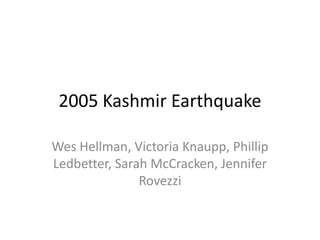
2005 kashmir earthquake
- 1. 2005 Kashmir Earthquake Wes Hellman, Victoria Knaupp, Phillip Ledbetter, Sarah McCracken, Jennifer Rovezzi
- 2. the cause of the quake
- 3. magnitude • “A magnitude-7.6 earthquake shook the Kashmir region, which is shared by India and Pakistan, on Saturday morning, Oct. 8. In the hours and days that followed, more than a dozen major aftershocks continued to shake the region, including a magnitude-6.2 event two hours after the main temblor.” http://www.geotimes.org/oct05/WebExtra10100 5.html
- 4. Warning • No Warning • Little to No preparation
- 5. Degree of Preparation • Most of the buildings in the affected area are of nonengineered unreinforced masonry (URM) wall construction. • The smaller villages also contain adobe structures that, as expected, performed poorly in the earthquake. • Preparedness and strict Seismic Building Codes could have mitigated the extent of the damage and could have reduced significantly the death toll - perhaps by as much as 80%. • Future Objective: To build institutions, structures, policies and enhance capacities for disaster risk management for communities and societies.
- 7. Local Response • Due to the vast extent of the earthquake, the Pakistan military forces were put in charge of coordinating the emergency response for the government. Since the basic infrastructure was severely damaged allowing limited access by road, the government used a fleet of donated helicopters to transport emergency supplies and evacuate the wounded. • The impact on the government was staggering. Most government officials were unavailable, some were dead, some were attending to their deceased and injured relatives and some were in shock and confused. Therefore, there was a total dependency on the military to organise relief efforts and to create a response structure. As a result, there was no truly functioning civil administration in the region; and, the Army generals were placed in charge of the operation.
- 8. International Response • No disaster management organisation existed to handle a relief operation on such a large scale, and the existing infrastructure was either very poor or totally destroyed.” • The scale of the disaster, the harsh weather conditions and the collapse of civil order in the affected areas called for a response mechanism which could provide quick decision-making, coupled with the efficient execution of directives on ground. • 'We were overwhelmed by the generosity of the world community and voluntary organisations, and the work of volunteers, men and women, aid workers, international organisations, NGOs and global civil society deserves the highest praise. Donors in particular need special mention for their generous support and assistance in providing relief to the earthquake victims.'”
- 9. Contributors • Tunisia, Afghanistan, Cambodia, People's Republic of China, Hong Kong, India, Indonesia, Iran, Israel, Jordan, Japan, Kuwait, Malaysia, Nepal, Pakistan, Qatar, Saudi Arabia, Singapore, South Korea, Turkey, United Arab Emirates, Norway, Poland, Belgium, Czech Republic, Denmark, Estonia, Finland, France, Germany, Netherlands, Russia, Sweden, Switzerland, United Kingdom, Canada, Cuba, United States, Australia, New Zealand, United Nations, Children's Fund, United Nations World Food Programme, United Nations Population Fund and the International Nongovernmental Organizations Forum, The Office for the Coordination of Humanitarian Affairs, World Health Organization, European Union, Organisation of the Islamic Conference, World Bank Group, Humanity First, Direct Relief International, Oxfam, The International Rescue Corps, Red Crescent, The Salvation Army, SOS Children's Villages, The Minhaj Welfare, Foundation, The Edhi Foundation, The World Islamic Mission Welfare Trust, SPO, DEMIRA Deutsche Minenraeumer e.V., and JEN Japan Emergency NGOs
- 10. Aftermath • “After 5 years, earthquake affected population of Pakistan is still waiting for rehabilitation. The government, as usual, stopped short of its commitments, leaving its people without homes and basic necessities of life.” • Why? Because the rough terrain is making it challenging for repairs.
- 11. Situation Today “It was an absolutely massive landslide and the landscape has been scarred. Parts of the district still look like a disaster zone. People are living in refugee camps around the city. Many houses are still rubble. A number of aid organisations have pulled back and these people are still living in camps with serious water and sanitation problems. The earthquake had a severe psychological impact on the people here. Morbid depression is common. I met a 60-year-old man in Balakot who had attempted suicide. He told me his wife, son and grandchildren had died. Only he was left alive and he had no idea what to do. He felt he had no purpose in life. […] I was amazed by the generosity of the people of Pakistan. I have seen some reconstruction and rebuilding by the government and some of the agencies. People have been given money to make their homes but not everyone got their share.” - Dr. Ifran Noor
- 13. How does the overall degree of development of a country affect ability to respond to a disaster?
